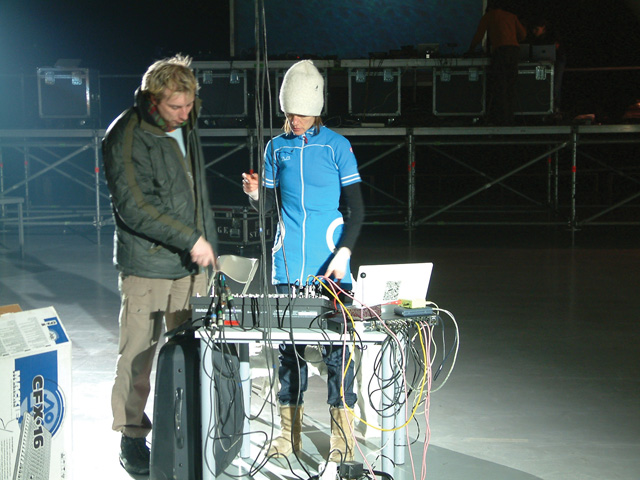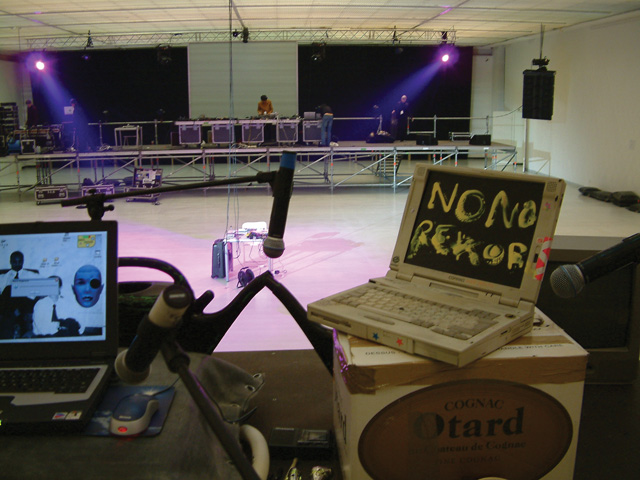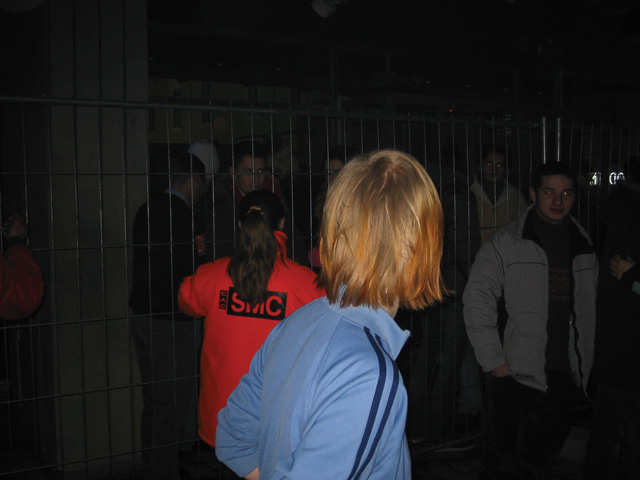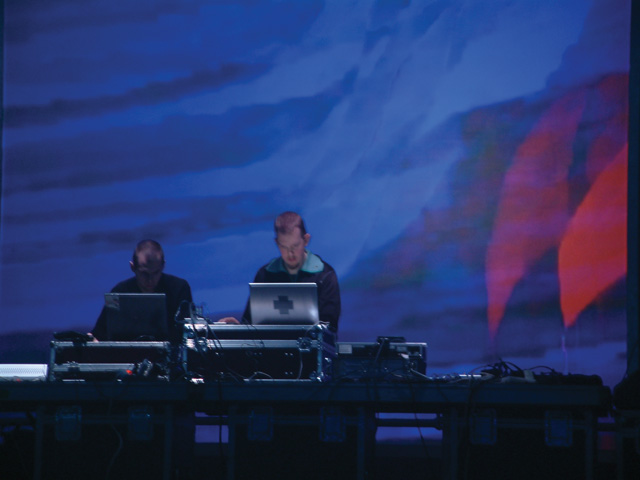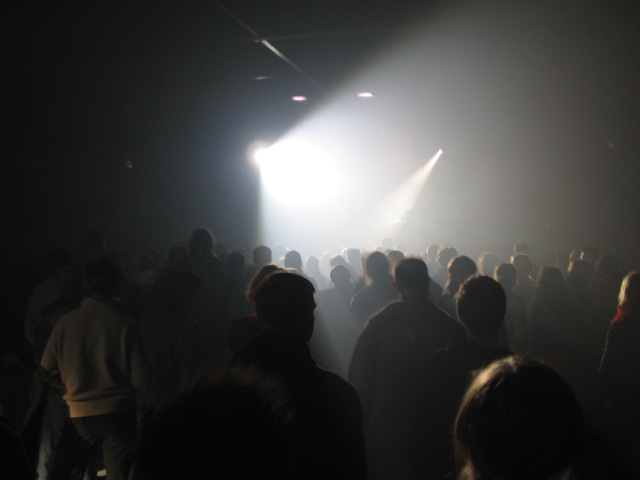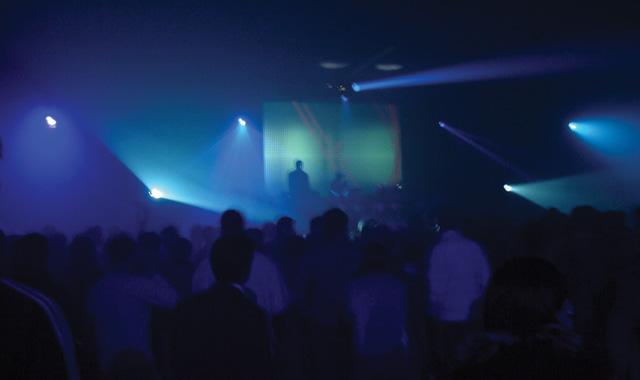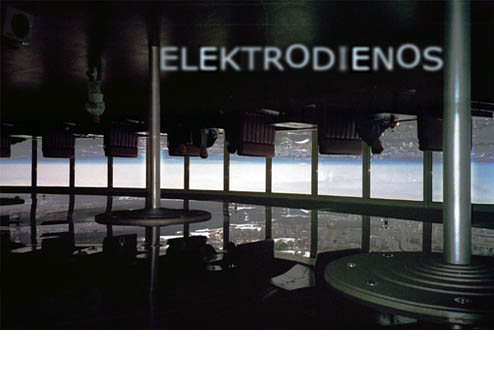
Participants:
Rosa Barba (Cologne), [email protected] (Kaunas / Marijampole), Club Mikshys (Vilnius), Deadbeat (Montreal), Egle (Vilnius), Kiwa (Tallinn), Nathalie Bruys aka KODI (Amsterdam), Ignas Krunglevicius (Oslo), Byungjun Kwon & Ge-Suk Yeo (Seoul), Korb/Instancija/Skiox (Vilnius), Andres Loo aka ARS INTEL Inc. (Tallinn), Loop-Not-Loop (Vilnius), Kaffe Matthews (London), Monolake (Berlin), Mouse on Mars (Dusseldorf / Cologne), Neva (Vilnius), Jonas Ohlsson (Amsterdam), Overtone (Vilnius), Alexej Paryla (Berlin), pb8 (Vilnius), Pink Twins (Helsinki), Gintaras Sodeika (Vilnius), Sutekh (San Francisco), Stewart Walker (Boston / Berlin), zw-x (Vilnius)
Orgainisers:
The Contemporary Art Centre,
Vilnius & GOIO: Group of Independent Observers (Vilnius)
WHAT?
A selection of some of the most innovative sound-artists will be invited to the Contemporary Art Centre in Vilnius www.cac.lt to produce what will be 2 days and 3 nights of undefined frequencies at the speed of the mix.
WHERE?
City: Vilnius is a patchwork of different cities, constructed in different periods through different visions of a present-future, sets of streets often refer to streets in other neighborhoods, sometimes in other cities, possibly with other purposes or headings in mind. The capital of one of the former Soviet Union republics is an open field for liberal democracy to interact with the heritage of communist planning, yet before the major investments of global capital has reached the city, a bronze monument for anarchomposer Frank Zappa stood up in one of the squares as a homage for anarchy that never sleeps.
Venue: The Contemporary Art Centre, Vilnius www.cac.lt, often functions as a platform for difference, sometimes inviting the inassimilable or unthinkable into the centre to engage the public in a discussion about the changing role of culture in everyday life. During the Elektrodienos (Elektrodays) CAC will become a sputnik, traveling to the zone of undefined frequencies, unrestricted speed and unidentified sound objects.
Space: the big room is a rectangular space of 1000 square meters that will contain two high platforms with separate sets of turntables / desktops.
HOW? (the logic of the mix)
There are a number of reasons for this particular concept of Elektrodienos. First, there‘s a technological aspect since all the artists invited use of electronic technology and simple, widely available tools like laptop, thus bringing the production of music/art into a democratic participation of everyone. At the same time there‘s a certain scale of technology ranging from custom-made software to Theremin and turntables.
The logic of the event is comparable to logic of the mix, but it encompasses more than sound tracks or different sound cultures, it‘s about horizontal and self-regulation-based mixing of:
– sound with vision;
– sound/vision with architecture;
– DJs with DJs;
– DJs with artists;
– artists with artists;
– aesthetics with politics;
– academy with club;
– theory with body,
– life with live.
Mix is the tool of experiment, experience and interpretation, involving established artefacts and not yet public sensations into a self-deconstructing flow. Rhythm A mixes with rhythm B, inventing a new rhythm X while a performer A becomes performer B by playing the laptop of a performer X. Thus, the event invents not only new cultures of sound but also figures producing them.
HOW? (Remixology)
‘Remixology doesn‘t replace a track so much as proliferate it into parallel alter dimensions. Remixology is the science of continuation and the art of drastic remaking, total remaking, remodeling.’ (Kodwo Eshun)
Live remix is not the last intention of Elektrodienos.
FREQUENTLY ASKED QUESTIONS (FAQ)
What is your motivation for this event?
The basic idea of inviting audio-artists to the CAC in Vilnius is rather simple: we want to introduce experimental and cutting-edge artists that transcend both dance-club and academic industries (and thus do not obtain their niche here) for Vilnius audience. The focus is rather on producers and artists (sometimes working as DJs) of experimental electronic music who are trying to extend the concept of music as well as construct new ways of its experience via different technological channels and methods. The solutions discovered in electronic music often become a source of avant-garde recipes and strategies to more conservative practices such as art and cinema. The remix of an audio track can be released before the original itself, a performer can multiply via different heteronyms and conceive products that have nothing in common (thus ensuring the freedom of multi-ego in the culture industry ruled by the tyranny of brands and signature), and the most complex piece can be produced without leaving a bedroom. This is just to say that electronic music isn‘t only the place of aesthetics but also of political invention despite all its trivialization by commerce.
Do you have any theoretical grounds for this experiment?
In a recent talk in New York, the philosopher Alain Badiou spoke about art as a process of purification as opposed to one of pure rupture (as the art and music worlds would often have you believe), a passage whereby ideas, possibilities, or more specifically problems are played out. What remains irrefutably one of the greatest stories from the culture of “the mix”, is not only its ability to find the new inside the old, but also its ability to physically embed the old within the new and in doing so, preserving, even foregrounding this passage Badiou describes.
Who program the event?
The Contemporary Art Centre, Vilnius & GOIO: Group of Independent Observers (Vilnius)
www.cac.lt, [email protected], Contemporary Art Centre, Vokieciu str. 2, Vilnius
– – – – – – – – – – – –
Rosa Barba March 5
‘Skin, membrane, and film – a border between inner and outer, a defensive barrier and medium of both sensitivity and vulnerability, structured by the interplay of light and shadow. Rosa Barba‘s work moves between the material conditions of cinematography‘s earliest years and the “here and now” of her imaginative power.’ – Siegfried Zielinski
Rosa Barba is a video artist and a photographer living in Cologne. She works on installations, films and video clips, as well as live performances with such formations as Niobe, Microstoria and Mouse on Mars.
> www.rosabarba.com
Nathalie Bruys aka KODI March 4
Nathalie Bruys from Amsterdam makes sound installations and performances, film, radio pieces, designs her own record covers, acts as DJ and organizes events. She creates sound often using found digital and analogue samples and giving them new meanings in combination, modified tempo, filters, etc.
‘Her sound experiments occasionally recall the early electro music of Kraftwerk but in her work the “cold” synthesizer chords often acquire a “warm” melody line and a more “analogue” sound. This may have something to do with the fact that she likes to work with old, one could almost say antique, sources of sound. On her LP KODI but more particularly during her live performances this fascination with the equipment itself and her delight in the specific “texture” of the collected material is clearly audible.’ – Nina Folkersma
Byungjun Kwon & Ge-Suk Yeo March 5
Byungjun has been playing an important role in South Korean underground music scene since 90s. Born in 1971 and living in Seoul, he creates music for records, sound tracks, fashion collections, contemporary dance, theatre plays and interdisciplinary events. He also writes scores for traditional Korean instruments and speaks about dance through Morse code and a string quartet…
Concert ‘e-‘ is an electro-acoustic live performance of Byungjun and Ge-Suk Yeo. She is a lyric-dramatic soprano and a novelty in the experimental and avant-garde music scene in Europe. With their interdisciplinary background they merge academic contemporary music, IDM, club dance and visual art into a newly sounding experimental electro opera.
> www.buyngjun.pe.kr
[email protected] March 5
Darius Ciuta (based in Kaunas) performs in Elektrodienos as [email protected] with an assistance of Gintas K (based in Marijampole); visuals by Neva (Vaclovas Nevcesauskas, Vilnius).
According to the website of an experimental electronic music project ‘Garso zona’, Darius Ciuta makes click&cut, microsound, conceptual sound art. In the last decade Darius Ciuta was famous for his noise music but recently he has turned to the non-linear, nearly muted explorations of sound and it‘s conceptual meanings. The musical style of Gintas K or Gintas Kraptavicius could be described as an eclectic mix of minimal techno, industrial sounds, experiments with frequencies – including pure sine waves and expressive overladen sound structures.
The performance of [email protected] introduces the /vyza/ label.
Club Mikshys March 4
Darius Miksys revisited his own ideas on participation, pleasure and communication when Dean Daderko (Parlour Projects, New York) invited him to participate in the 24/7 project as a way to integrate his creative skills of engaging in a context of the exhibition. He set up an access for the interested to experience the diversity of Mikshys clubbing. One way to receive the information was to be infected with SoBig.F virus (which should have been gone by September 10th, 2003) since Darius compiled his mailing list from the spam messages he received. The other way is to ask for pyjamas at the CAC counter.
Elektrodienos will start with Club Mikshys project which will introduce a number of Lithuanian DJs mixing three tracks: the first DJ will mix the first track with the second, the second DJ will mix the latter with the third, the third DJ – the third with the first track, and so on. The project will last only half an hour but it‘s motto exemplifies the idea that difference has no limits.
> www.clubmikshys.com
Deadbeat March 4
‘… recently the German label ~scape released Something Borrowed, Something Blue, a new album of him. /…/ His music presents an intriguing hybrid of dub and Berlin techno but in this album the boundaries are pushed further: Deadbeat moves on. The ideas from Wild Life Documentaries are brought to a higher state, the sounds of the album are even less tangible, and the dub echoes are even more mystical… All this os just to say that seeing him play in Elektrodienos together with Monolake will be a stunning experience.’ – Walkman, www.sutemos.net
Deadbeat is Scott Monteith, based in Montreal, who makes and releases a very specific minimal electronic music. In Elektrodienos he will play along with Robert Henke (Monolake); both artists are bound by a project ‘Atlantic Waves’ – transatlantic live performances via Internet.
> www.techno.ca/deadbeat
Egle March 5
Video artist based in Vilnius whose net of collaborations stretches from taking part in the activities and inactivities of the fluid So-Called Records identity to founding of a group of STBY RECords: ‘in the STBY phase the ideas are RECorded. These are the very essential records but they were made before the button REC was pushed.’
Ki wa March 5
Ki wa (in Elektrodienos – Olaf Andvarafor‘s Project) is a young artist from Estonia. Well-known for his critically acclaimed works that are often taken as pop art, but as it‘s been growing and attaching some deeper layers in it, it is now a matter of the so called proto art. Ki wa‘s rating in local art world fell visibly when it became a public fact, that he is not only a ‘pop-artist’ but really participates in fashion shows & converse with cute teen models as well as any other Warhol…
> www.looming.org
Korb/Instancija/Skiox March 6
> www.rgb.lt
Ignas Krunglevicius March 5
‘… since we are living in world of everything in-one, since we are completely deconstructed and confused, obviously, there is no other choice than to create the direction and that direction is style.” (…) DOGMA: no “pseudo intuitive” improvisation; no eclectic material; no unnecessary ornaments; …’ These are excerpts from the Synthetic Style Manifesto by Ignas Krunglevicius (b. 1979, Kaunas), who studies composition in Oslo Music Academy and has made more collaborations with visual artists than live performances in CAC.
Mind Loop was first realised in CAC in 2001 during the first gig of Monolake in Vilnius; decomposed and reprogrammed pieces of Stewart Walker wrapped the cinema hall via multiple sound sources.
Andres Loo aka ARS INTEL Inc. March 5
Andres Loo from Tallinn is a musician, a journalist, an artist, a founder member of the Looming Environment, administrator of looming.org web-space, curator of 1+1=1 Multimedia Research Lab and a member of Metabor Group.
In the mid-1990s and late-1990s he was involved in organizing various underground- and jazz related events, also practiced creative-DJing under pseudonym A as for Alfa. Later on Andres has taken part in several sound art projects and installation exhibitions – personal exhibitions ‘A-ruum‘ and ‘Allusions to Power‘ included. He is now applying experiences of his creative work to development of the brave new sound. He is particularly interested in the potential of vibration and other means for enhancing transcendental communication, encouraging artistic expression and facilitating democratic participation.
> www.looming.org
Loop-Not-Loop March 6
Loop-Not-Loop is a project by Andrius Alien, a member of the Happyendless group and producer of the first Lithuanian platinum album of house music (SEL ‘Guma’), who together with Marius Narbutis produced a number of remixes for the mainstream music scene; a lot of these remixes have reached the Lithuanian Top 5.
Loop-Not-Loop is his first project made for a specific event. It‘s sound might be described as experimental minimal electro tribal with a lot of attention to the rhythmical/electro-percussion line.
> www.happyendless.com
Kaffe Matthews March 5
Kaffe Matthews is one of the most active artists on the new electronic music scene, whose surprisingly rare approach exploiting digital gadgets and live performance has resulted in some unique works that transgress any boundary between sound and image. Since 1996 she has been regularly performing all over the world in clubs, galleries, concert halls, tea rooms, boats, warehouses, the outback, releasing the best of these events on the six CDs, presenting an annual document of her ever developing sound worlds. In some of these worlds, she collaborates not only with various sound and visual artists, but also with weather conditions, cell phones and the venue of the unique performance via live sampling.
‘Kaffe Matthews is one of the most enduring figures in London‘s improvised music scene, and her recent conversion from processed violin to software based transformations of space has opened up her music to a multitude of contexts, including radio art, a sonic armchair and music for astronauts.’ – Will Montgomery in the WIRE magazine, September 2003
> www.annetteworks.com
Monolake March 4
”Cinemascope” by Monolake must be the best introduction to the wonders of the minimalist world. It‘s a mixture of textures and moods for a slightly tired urban kid longing for experiments. “Cinemascope” enriches silence in a discreet, maybe even elegant way, and gradually carries one to the world unfolding beyond it. You find yourself in a space where a formula of mathematics becomes a sound, a succession of numbers becomes a combination of sounds, and a galaxy of successions turns into a world of sound. There are no more limits between source and effect when nuclear information becomes visible…’ – Nebylusis Fleitistas, www.ore.lt
Founded in 1995 by Robert Henke and Gerhard Behles, Monolake from the early on was a musical project which combined influences from club culture and the sophisticated sound design of academic computer music in order to create a very unique world of beats, structure and sound. Now probably it could be best described as minimal techno with a certain noticeable breakbeat and electro influence. In the last eight years Monolake has released five albums, a number of 12 inches and several remixes, most of it released on Henkes own label Monolake / Imbalance Computer Music. Monolake is also behind the revolutionary software Ableton Live.
Robert Henke performs in Vilnius for the third time, sharing space and time with Scott Monteith (Deadbeat). Video by Alexej Paryla.
> www.monolake.de
Mouse on Mars March 5
Mouse on Mars formed in 1993 when Andi Toma, from Dusseldorf, and Jan St. Werner, from Cologne, met at a metal festival in Stockholm and decided to form a band. With seven albums and nine e.p.‘s Mouse On Mars have gained a reputation as one of the most innovative and productive bands of today‘s popular music scene.
‘Mouse On Mars have paved the way for a continuously growing gang of German and international sound villains to weave analogue and digital, electronic and non-electronic sounds in a totally new, organic fabric. Not without reason have great swarms of independent and other tinkerers, post-, kraut- and general rockers, techno types and avant-garde scoundrels included this darned modern stuff in their daily menu. Their experiments can be traced in the high tech mainstream productions of the likes of Missy Elliot or Smashing Pumpkins as well as avant dance bands as Bjork, Radiohead or David Byrne.’ – www.sonig.de
‘For me, our music reflects society; it reflects randomness and a certain incalculable combination of units and entities. So, I could also see a cosmic quality in there, with things colliding and crashing. There‘s absurdity, there‘s something that you as a human being cannot find sense in there. There are other things that make perfect sense, and they come across as being harmonic and rhythmic, and they appear and you can immediately cling to it. Some aspects of it are cultural, they deal with issues that you learn to deal with and that you carry around as being a human. Then there are elements that touch you quite personally, because they have a mix of absurdity and something that is explained, and you just react to it as a single being.
(…) There‘s randomness that you have when you just sit in a caféé and you see people moving by, and there are strange algorithms that provide you with new random patterns all the time. People are showing up, they‘re disappearing, and suddenly there‘s one again. There‘s a certain rhythm in there, but you cannot really strip down that rhythm, you don‘t find a logic for that. That‘s what our music tries to display.’ – Jan Werner
Neva March 5
Means of work for Vaclovas Nevcesauskas are photography, video, animation, sound, contemporary devices of communication, sociological research, etc. With a sinclair computer and a pc he has made video sattelites for Lithuanian sound artist and composers, e.g. Atrac, Darius Ciuta and Gintaras Sodeika. Seemingly abstract, they often explore or search for sensations and subconsciousness.
Jonas Ohlsson March 4
Jonas Ohlsson is a Swedish artist and musician based in Amsterdam who lectures and performs worldwide. In Vilnius he will give lectures on the history of relation of sound and visual arts and will appear on stage together with Nathalie Bruys aka KODI.
Jonas Ohlsson DJs everything from Detroit techno and acid Jamaican Dancehall, Hip Hop, Samba, experimental electronica, country, melodic psychedelic pop, Brazilian capoeira, dub, kraut, industrial, mambo, etc, etc.
Overtone March 4
Paulius Kilbauskas – programmer, music producer and composer, Giedre Vitkauskaite – vocalist of the group ‘Empti’, and Saulius Prusaitis. Dub-elektro-ragga.
Alexej Paryla March 4
During a Monolake live show the video footage is mixed, layered and processed to create a constant flow of visual stimulation by Alexej Paryla. The video footage itself is the result of digital processing on recorded minute details of our technical and non-technical environment.
PB8 March 4
PB8 is Andrius Rugys, agent of a Group of Independent Observers and an artist working with audio, video and light. This pseudonym is a visual progression of ornaments based on one of the personal algorithms of minimalism. P has one ‘belly‘; B has two; 8 is an ornament that allows individual interpretations. Pseudonym is a ‘code‘ for understanding author‘s work. For PB8, the main feature of minimalism is a system of repetition (a loop) that regularly adopts new elements and carries to the irreturnability, an interpretation of being.
The journey through the audio channels by PB8 stretches from scratches to the noise of an underground train via eclectism of urban sound that projects the organic rhythm on the low analogue frequencies.
Pink Twins March 6
‘The Finnish duo Pink Twins, the brothers Vesa and Juha Vehvilainen, started to work together in 1997. Since then they have been exploring visual and sonic noise combined in a most physical experience. Sampling the everyday images and tearing them apart to pixels then putting them together again to a chaotic and blasting unity. /…/
Scratches, fuzz, noises and weird and warped rhythms are combined with images to a mosaic flow that which you perceive not only with your seeing but also with all your senses. The result spellbinds you and surrounds you with a complexity. What they achieve puts you inside the a digital dynamic weave of crumbles of the reality.’ – Bjorn Norberg
> www.pinktwins.com
Gintaras Sodeika March 6
‘Gintaras Sodeika is best known for his music for theatre productions. At the beginning of his career, Sodeika‘s work was informed with unconventionality – happenings, site-specific works, sound installations, and compositions of instrumental theatre. The concert trend of his music is also noted for certain theatricality and references to contemporary pop culture. The composer himself describes his works of recent years as “academic techno” – a whimsical combination of traditional musical values with new technologies. His “Tone Ontology No.2” – an intriguing stylisation of techno music for traditional instruments in a traditional concert setting – enjoys particular popularity. The other works of Sodeika often combine elements of minimalism and jazz, and are not void of bizarre humour and self-irony.’ – Linas Paulauskis
Sutekh March 6
‘The boundaries of electronic music have blurred due to recent advances in technology and a new genre of music has developed over the past couple of years. Some fans call it “microsound”, others call it “glitch”, “lowercase”, or “post digital”. When it‘s applied to the dancefloor it‘s called “micro-house”, “click-techno”, “abstract-dub-tech-funk” or “minimal tek”. Sutekh – aka Mr Seth Horvitz from San Francisco – is at the forefront of this new wave of music. Sutekh seeks to prove that techno music is about exploring new sounds and rhythms, experimenting with form and function beyond predictable, thumping beats – pure sonic experimentation with dancefloor structures.’ – Philip Sherburne
Manipulating computers, samplers, synthesizers, ping-pong tables, Scrabble pieces, and found sounds, he has created everything from minimal house and techno to dense, dissonant noise collage.
‘Sutekh has quickly become one of the key scene leaders in the world of experimental techno’ – BBC
‘The most exciting artist working in electronic music today.’ – www.4dance-music.com
> www.context.fm
Stewart Walker March 6
Born and raised in Atlanta he was moving from place to place until he got to Berlin. It is a bit insane that his music in the EDM and IDM circles is often being reflected as ‘minimal’, although Walker‘s music carries influences by The Cure as well as epoch Baroque. In 2001 he established his own label ‘Persona’ with only one reason: to bring back personality to the techno music.
‘I don‘t see a future for purist techno anymore. I say this because the root philosophy of techno music was to utilize out-there sounds while remaining fun and danceable. Now that the equipment used to create techno is so ubiquitous, it‘s hard to fire up an unknown synth with a crazy sound and let it ride over a steady kick drum for 6 minutes. The ‘shock of the new‘ has passed and now we are faced with a number of future possibilities. The purist way is utilizing the new computer programs to faithfully recreate the sound of old analog gear. And from they‘re choosing to honor the form of the original techno tracks. As you might imagine, this is not my favourite possibility and I feel grateful that I‘m not frequently confronted with an old school movement in techno.’ – Stewart Walker, interview in cued-up.com
> www.stewartwalker.com > www.personarecords.com
zw-x March 6
‘Memorable: light artist Eugenijus Sabaliauskas for the killing light of love, shadows and the burning passionate dusk in “Romeo and Juliet” by Oskaras Korsunovas Theatre’ – Valdas Gedgaudas, 7 meno dienos, 2003-12-26
X-RAY concentrated on one style – hardcore – since he began collecting records in 1995 until he met with ZWB, a future leader of the Group of Independent Observers, who drew him into minimal in 2001. X-RAY still propagates hardcore and remains a flagman of Lithuanian hardcore scene.
